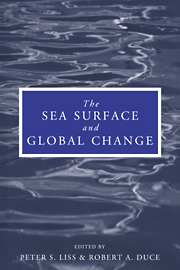Book contents
- Frontmatter
- Contents
- List of contributors
- Preface
- 1 Report Group 1 – Physical processes in the microlayer and the air–sea exchange of trace gases
- 2 Report Group 2 – Biological effects of chemical and radiative change in the sea surface
- 3 Report Group 3 – Photochemistry in the sea-surface microlayer
- 4 Transport processes in the sea-surface microlayer
- 5 The role of organic films in air–sea gas exchange
- 6 Bubbles and their role in gas exchange
- 7 The physical chemistry of air–sea gas exchange
- 8 The sea-surface microlayer and its effect on global air–sea gas transfer
- 9 Chemistry of the sea-surface microlayer
- 10 Biophysics of the surface film of aquatic ecosystems
- 11 Biological effects of chemicals in the sea-surface microlayer
- 12 Neuston of seas and oceans
- 13 Photochemistry in the sea-surface microlayer
- 14 Hydrocarbon breakdown in the sea-surface microlayer
- 15 Applications of laser technology and laser spectroscopy in studies of the ocean microlayer
- 16 Remote sensing of the sea-surface microlayer
- Index
5 - The role of organic films in air–sea gas exchange
Published online by Cambridge University Press: 24 September 2009
- Frontmatter
- Contents
- List of contributors
- Preface
- 1 Report Group 1 – Physical processes in the microlayer and the air–sea exchange of trace gases
- 2 Report Group 2 – Biological effects of chemical and radiative change in the sea surface
- 3 Report Group 3 – Photochemistry in the sea-surface microlayer
- 4 Transport processes in the sea-surface microlayer
- 5 The role of organic films in air–sea gas exchange
- 6 Bubbles and their role in gas exchange
- 7 The physical chemistry of air–sea gas exchange
- 8 The sea-surface microlayer and its effect on global air–sea gas transfer
- 9 Chemistry of the sea-surface microlayer
- 10 Biophysics of the surface film of aquatic ecosystems
- 11 Biological effects of chemicals in the sea-surface microlayer
- 12 Neuston of seas and oceans
- 13 Photochemistry in the sea-surface microlayer
- 14 Hydrocarbon breakdown in the sea-surface microlayer
- 15 Applications of laser technology and laser spectroscopy in studies of the ocean microlayer
- 16 Remote sensing of the sea-surface microlayer
- Index
Summary
Abstract
Various parameterizations of gas exchange with wind speed at the ocean surface are poorly constrained by field measurements using natural and artificial tracers. One of the factors leading to uncertainty for in situ estimates of the gas transfer velocity is the presence of organic films at the air–sea interface. Such films are derived from bulk seawater dissolved organic matter, from terrestrial sources (natural and anthropogenic) and from petroleum seeps and spills. The ubiquitous background of degraded natural biopolymeric and geopolymeric materials in the sea potentially contributes to surface accumulations of organic matter even in very oligotrophic waters. Specific inputs during phytoplankton blooms and from neuston in the microlayer also contribute to the enrichment of surface-active matter at the interface.
Organic films can affect air–sea gas exchange through both static and dynamic mechanisms. The static effect arises from the presence of additional mass transfer resistance due to the physical barrier provided by the film. This effect is not considered to be important at the sea surface, since it requires the presence of condensed, solid type surfactant films that are easily dispersed under typical oceanic conditions of wind and waves. Much more significant is the hydrodynamic effect of a film that arises from the viscoelastic property of a surfactant-influenced interface.
- Type
- Chapter
- Information
- The Sea Surface and Global Change , pp. 121 - 172Publisher: Cambridge University PressPrint publication year: 1997
- 91
- Cited by



